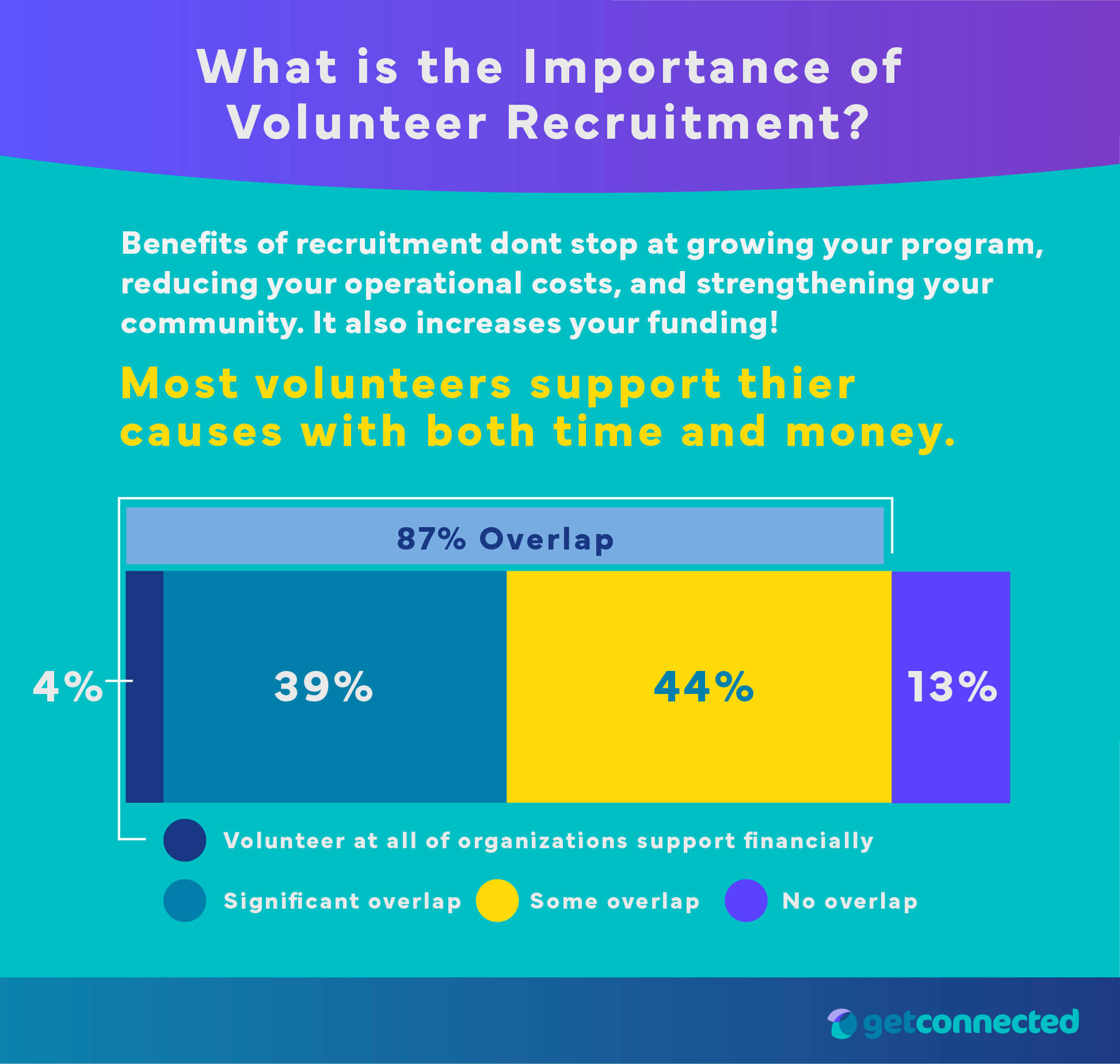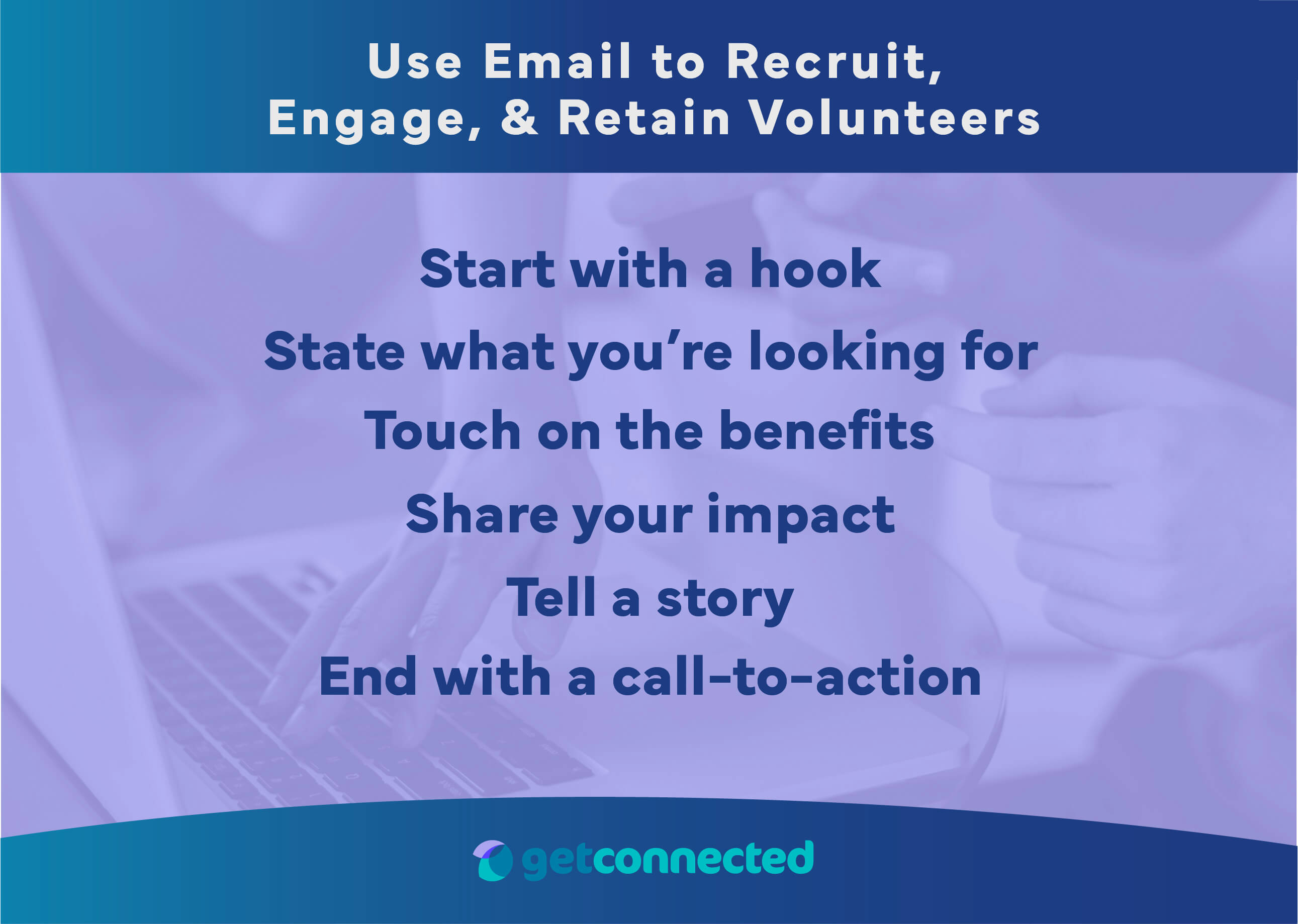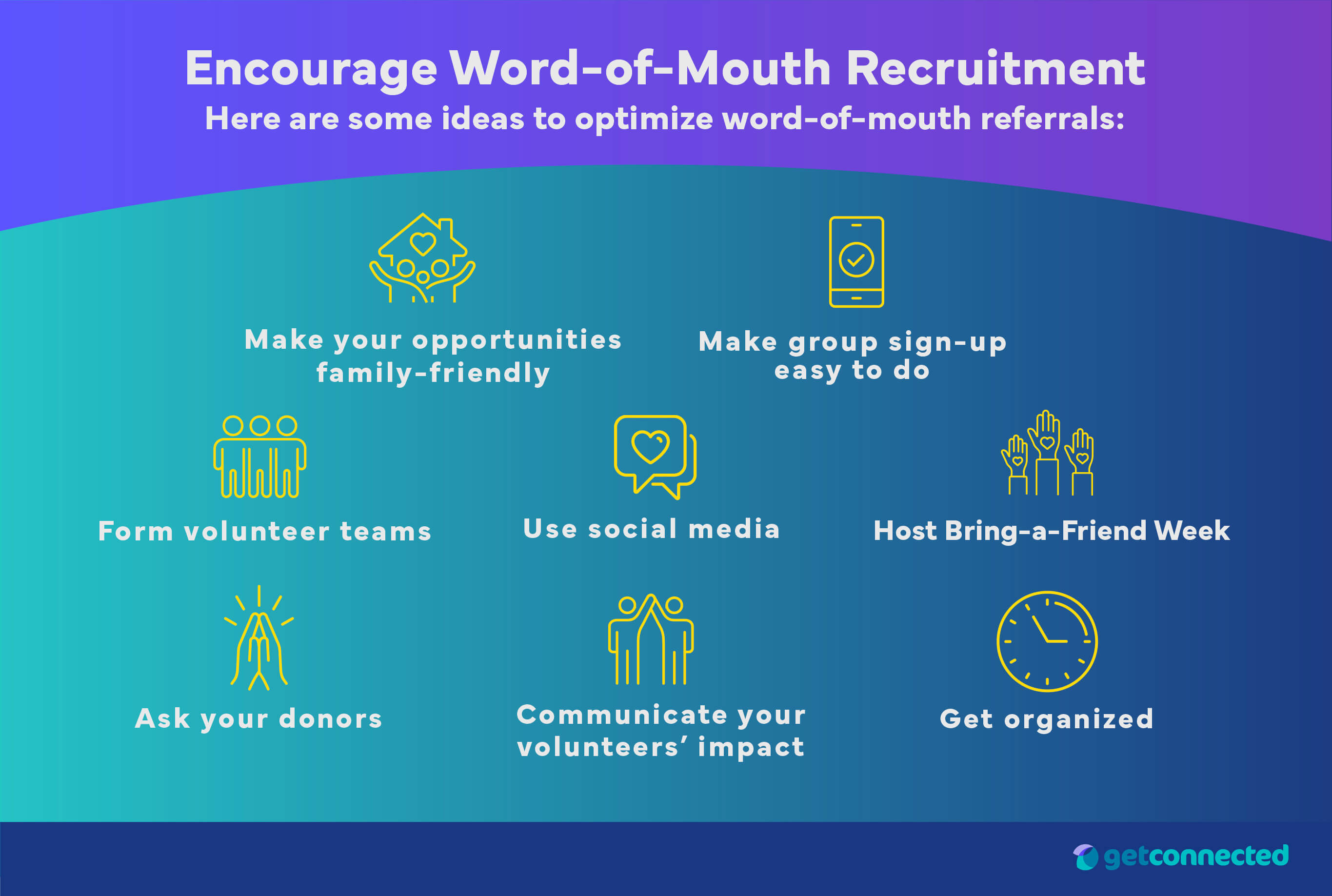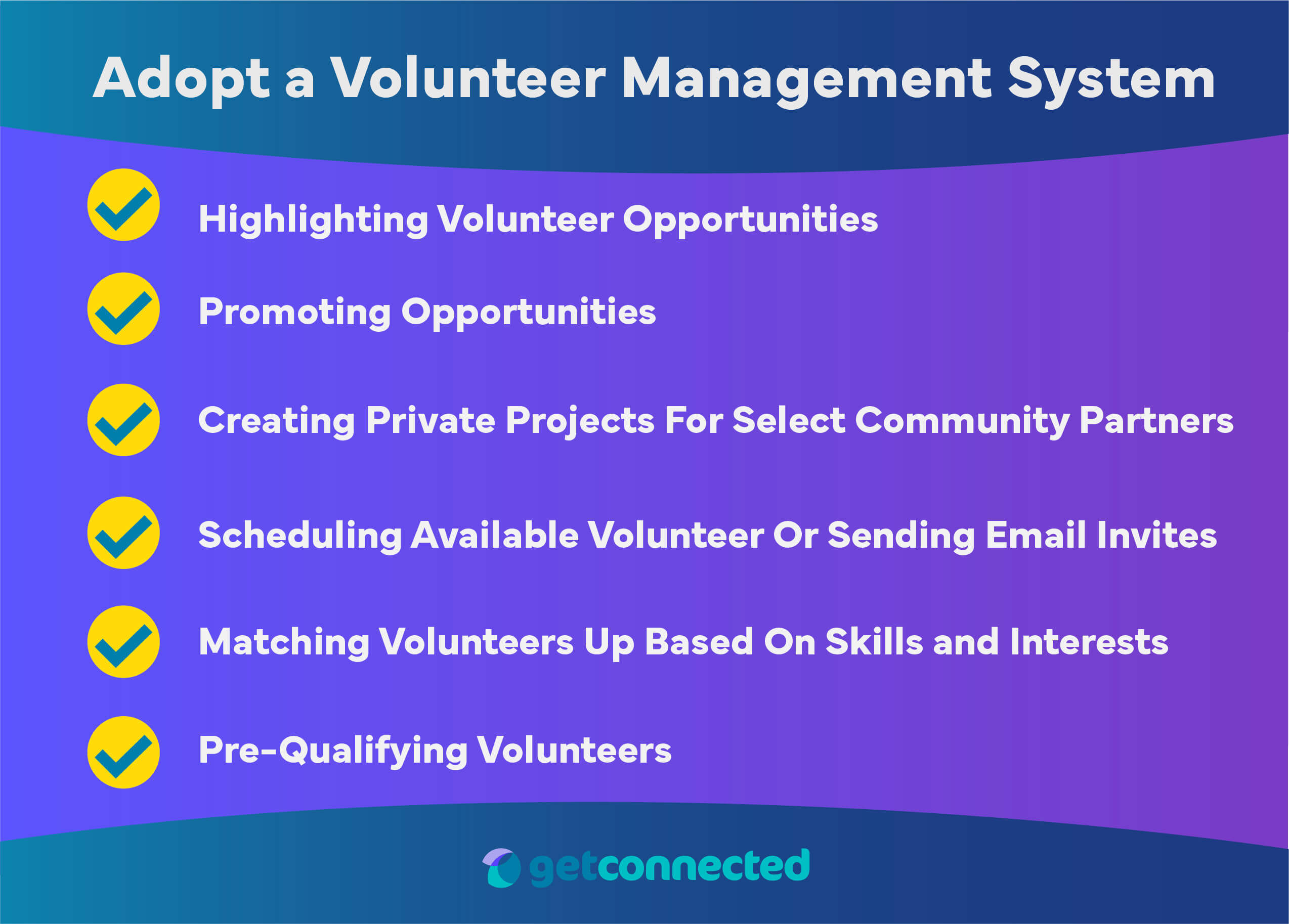Free Volunteer Recruitment eBook
Recruiting volunteers is an integral part of the volunteer management process. In fact, it’s one of the first elements that volunteer professionals look to when developing a successful and sustainable volunteer program.
But, lots of nonprofits struggle with it—according to research, 62% of nonprofits state that recruiting volunteers is “a big problem.”
In this blog, we’ll cover the top 11 volunteer recruitment ideas your nonprofit can use to make recruitment simple, smooth, and efficient — and bring more volunteers to your mission than ever before.
What is Volunteer Recruitment?
Volunteer recruitment is the process by which organizations identify and invite individuals to contribute to their cause.
It’s about reaching out, sharing what kind of help is needed, and finding the right match between the volunteer’s interests and the organization’s needs.
Want to brush up on volunteer recruitment trends?
Access the full Volunteer Recruitment webinar, Certificate of Attendance, and bonus resources here
What is a Volunteer Recruitment Plan?
A volunteer recruitment strategy or plan organizes your recruitment efforts so that you can grow your volunteer pool and your impact in an efficient, sustainable, and scalable way.
A recruitment plan typically incorporates efficient tools and processes to consistently attract individuals to meet your volunteer needs while aligning with the ethos of your organization.
Why is Volunteer Recruitment Important?
There are numerous benefits to recruiting volunteers that extend beyond simply filling existing shifts.
Effective volunteer recruitment programs help nonprofits:
- Keep their mission moving forward: Volunteers provide the people-power needed to run programs, events, and services that support your cause.
- Increase funding: This Role of Volunteering in Philanthropy report found that volunteers donate ten times more money to charities than non-volunteers.
- Build long-term community support: Recruiting volunteers helps grow a network of supporters who care about your mission and may become future donors, advocates, or leaders.
- Reduce operational costs: Volunteers not only deliver services directly to clients, but they can also provide free support to day-to-day operations, such as marketing or fundraising.

Top 11 Ways to Recruit Volunteers
Now that we’ve covered the what and why of volunteer recruitment, let’s get to the good stuff.
In this section, we’ll learn how to find new volunteers and, even better, help volunteers find you.
1) Craft A Compelling Volunteer Recruitment Message
Your recruitment message is the key information you share with your community about your organization, inspiring them to join your cause. This message should be both enticing and authentic, representing your organization's collective voice.
To recruit volunteers effectively, your message should:
- Have a strong call to action (CTA): A clear, compelling prompt that tells your audience exactly what step to take next. Include a specific CTA whenever you pitch your volunteer program to community partners and prospective volunteers.
- Show personality: In a world of competing messages, your unique organizational voice helps you stand out. Let your authentic personality shine through and don't be afraid to make your content engaging and even fun when appropriate for your cause.
- Focus on your audience: Tailor your message to appeal to the specific demographic you're trying to reach. Consider their motivations, values, and what would resonate most with them about your volunteer opportunity.
- Highlight the impact: Clearly communicate how volunteers' contributions will make a meaningful difference. People are more likely to volunteer when they understand the tangible outcomes of their efforts.
- Keep it concise: Respect your audience's time by delivering your message efficiently. A clear, powerful message is more effective than a lengthy explanation.
- Create urgency: When appropriate, incorporate elements that encourage prompt response, such as limited spots available or seasonal opportunities.
Download the FREE Volunteer Recruitment eBook!
2) Master the Volunteer Job Description
An effective volunteer job description is crucial for attracting the right people to your cause. When potential volunteers clearly understand what they're signing up for, they're more likely to commit and stay engaged.
Your volunteer job description should include:
- Volunteer role title and purpose: Use a clear, appealing title that accurately reflects the position. Follow with a concise description of why this role matters to your organization's mission.
- Specific responsibilities: Detail exactly what volunteers will be doing. Break down tasks and expectations so there's no ambiguity about the role.
- Time commitment required: Be transparent about the hours needed (weekly/monthly), duration of commitment, and any flexibility in scheduling.
- Skills and qualifications: Distinguish between essential requirements and preferred qualifications. Include both hard skills (experience, certifications) and soft skills (communication, teamwork).
- Benefits and impact: Explain what volunteers will gain from the experience, whether that's professional development, social connections, or the satisfaction of making a difference. Quantify the impact of their contribution when possible.
- Training and support provided: Reassure potential volunteers that they won't be left to figure things out alone. Outline orientation procedures, ongoing training, and mentorship opportunities.
- Location and accessibility: Specify whether the role is remote, on-site, or hybrid. Include information about accessibility accommodations if applicable.
- Application process: Make it clear how interested individuals can apply and what they should expect during the selection process.
3) Make Your Recruitment Campaign Targeted
Instead of casting a wide net, opt for a more targeted recruitment strategy. Targeted recruitment directs your message to specific audiences, helping you find passionate volunteers with the exact skills and qualifications needed for your opportunities.
To create a targeted campaign for more successful volunteer engagement and recruitment, be sure to:
- Focus on specialized communities: Direct your recruitment materials toward smaller special interest groups, community Facebook and LinkedIn groups, cultural societies, language clubs, and professional associations where your ideal volunteers already gather.
- Segment your contacts: Leverage your CRM to identify potential volunteer groups based on data such as skills, interests, professional background, and previous engagement with your organization.
- Craft personalized appeals: Create specific asks that potential volunteers can immediately identify with. For example, "Are you a French-speaking professional who wants to make a difference in refugee families' lives? Your translation skills could transform someone's future."
- Utilize volunteer management software: Implement technology that tracks volunteers' preferences during registration and automatically recommends appropriate opportunities based on these preferences, creating a personalized experience.
Download the free Volunteer Recruitment eBook!
4) Use a Multichannel Outreach Approach
Don’t rely on just one method of communicating with supporters. When recruiting volunteers, consider reaching out through several different channels — you never know what will resonate.
For successful volunteer recruitment, consider using channels like:
- Text: Use a tool like Get Connected to send out text blasts, asking supporters to sign up. Include a snappy call to action like, “Calling all volunteers! We need you to help our annual 5K for Kids run smoothly.”
- Email and newsletters: Email marketing is remarkably cost-effective (the return on investment for email marketing is $42 for $1 spent). In other words, email is a great way to recruit supporters.

- Paid online advertising: Online advertising is especially effective for that big recruitment “push” to drive people searching for volunteer opportunities to your website or volunteer platform. We recommend taking advantage of Google Ad Grants.
- Social media: Leverage diverse platforms strategically—share organizational culture and event photos on Facebook and Instagram, post professional volunteer opportunities on LinkedIn, engage supporters with concise messaging on Twitter, and create compelling recruitment videos for YouTube that can be embedded across all your digital touchpoints.
Pro tip: Use Get Connected's Social Media Integrations to share opportunities, events, and community announcements straight from your volunteer platform.
Learn more about Get Connected's Social Media Integrations
5) Encourage Word-of-Mouth Recruitment
Word-of-mouth recruitment leverages the supporters you already have to recruit volunteers for you. The recruitment tactic encourages your current supporters and stakeholders to spread information about your programs to encourage like-minded people to volunteer or donate.
To optimize word-of-mouth referrals, be sure to:
- Leverage social media: Ask your supporters and followers to share a post that promotes your program.
- Host a “Bring-a-Friend Week”: Chances are, your volunteers hang out with like-minded folks. Encourage them to bring along friends and colleagues. Make volunteering a social occasion by providing opportunities for collaboration (and fun!).
- Form volunteer teams: Engage corporate teams, school groups, or faith-based organizations to volunteer as a group. It can help get more supporters through the door more quickly.

6) Form Meaningful Partnerships
One powerful way to recruit more volunteers is by teaming up with other organizations, schools, or businesses in your community. These partnerships can introduce your cause to new audiences and create a steady pipeline of willing and enthusiastic helpers.
Grow your network by working with like-minded organizations in your community like:
- Corporations: Employee volunteers offer professional skills, experience, and connections with other community members.
- Educational Institutions: Partner with local schools, colleges, and universities to create service-learning opportunities, internships, and class projects that fulfill academic requirements while supporting your mission.
- Faith Communities: Collaborate with churches, synagogues, mosques, and other religious organizations that have established service committees and congregants looking for meaningful volunteer experiences.
- Civic Groups: Engage with Rotary Clubs, Kiwanis, Lions Clubs, and chambers of commerce whose members are already committed to community service and have valuable professional networks.
- Youth Organizations: Form relationships with Scout troops, youth sports teams, and after-school programs seeking character-building service opportunities for their participants.
- Senior Centers: Partner with retirement communities and senior centers to tap into the wealth of experience, skills, and available time that retirees can contribute to your cause.
7) Prioritize Diversity and Inclusivity
Sustainable volunteer programs represent the diverse makeup and voices of their community members. To welcome new voices, reach out to leaders at community institutions that address diversity and equity, such as:
- Civic and cultural organizations
- Neighborhood associations
- Houses of worship
- Elected offices
- University clubs and Greek life organizations
- Small business owners
8) Make Volunteerism More Accessible
One of the best ways to recruit more volunteers is by making your volunteer program more accessible to a diverse range of people.
To do this, be sure to:
- Expand virtual volunteering: Virtual volunteering has become increasingly popular and is a great way to accommodate individuals who may be unable to commit to in-person volunteering due to location, time constraints, or physical limitations. You might offer virtual opportunities like online tutoring, administrative tasks, digital marketing, or remote project management.
- Promote wheelchair accessibility: By noting all types of accessibility, you enable potential volunteers to easily identify roles they will be comfortable in. Additionally, making accessibility a priority allows your volunteer program to connect with a larger, more diverse group of potential volunteers.
- Provide training and support: Ensure your team is trained to support volunteers with varying abilities appropriately. Training can cover effective communication, awareness of different abilities, and strategies to foster an inclusive environment.
- Adopt flexible scheduling: Some volunteers may be unable to commit to a strict schedule due to personal circumstances or health conditions. Flexible scheduling options, such as weekend volunteering or shift-based roles, can make your program more appealing.
- Make your opportunities family-friendly: This is a great way to get kids civically engaged from a young age and welcome new members, including parents who would otherwise need to secure childcare.
Don't Forget Your Free Resource: Download the Complete Guide to Volunteer Recruitment
9) Employ Volunteer Ambassadors
Your current supporters are your most valuable asset for onboarding new volunteers. Offer your most dedicated supporters leadership opportunities and boost your recruitment efforts by forming a volunteer ambassador program.
Volunteer ambassadors can boost your recruitment efforts through key recruitment activities, such as:
- Spreading the word through their networks
- Securing volunteer registrations
- Representing your organization in the community
Pro tip: Make sure to provide your volunteer ambassadors with the tools, resources, and mentorship to share your recruitment message.
10) Survey Your Current Volunteers
Your current volunteers can provide valuable insight into your program, highlighting areas of strength and opportunities for improvement.
To understand the effectiveness of your recruitment strategy, your volunteer survey should include questions like:
- How did you hear about our organization?
- What compelled you to volunteer with our organization?
- By which means did you register with our organization?
- Were you provided with a clear position description?
- Please rate the ease of locating and signing up for a volunteer opportunity.

11) Use an All-in-One Volunteer Management System
Volunteer recruitment is no simple task. That’s why many volunteer professionals rely on volunteer management software to find better candidates quicker.
Volunteer management software can assist with core recruitment functions, including:
- Highlighting volunteer opportunities: Make your volunteer opportunities stand out with a clean volunteer interface.
- Promoting opportunities: Share volunteer opportunities and events with a click by email, on your social media, or on your website’s homepage to direct prospects to your volunteering page.
- Creating private projects for select community partners: Create exclusive opportunities for select groups and report their collective impact.
- Matching volunteers up based on skills and interests: Engage volunteers by recommending volunteer opportunities based on their skills and passions. During registration, volunteers will self-select their interests, and the system will automatically recommend volunteer opportunities.
- Pre-qualifying volunteers: A drawn-out onboarding process can discourage eager supporters. During registration, the system should enable volunteers to quickly upload required qualifying documentation (like driver’s licenses or certifications) to their platform profile.
Ready to learn how volunteer management software can boost recruitment? Book a free Get Connected demo today.






